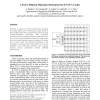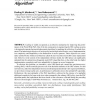508 search results - page 52 / 102 » DNS performance and the effectiveness of caching |
MICRO
1997
IEEE
13 years 12 months ago
1997
IEEE
Modern architectural trends in instruction-level parallelism (ILP) are to increase the computational power of microprocessors significantly. As a result, the demands on memory ha...
DATE
2009
IEEE
14 years 2 months ago
2009
IEEE
D-NUCA L2 caches are able to tolerate the increasing wire delay effects due to technology scaling thanks to their banked organization, broadcast line search and data promotion/dem...
RSA
2008
13 years 6 months ago
2008
ABSTRACT: Caching is widely recognized as an effective mechanism for improving the performance of the World Wide Web. One of the key components in engineering the Web caching syste...
WWW
2006
ACM
14 years 8 months ago
2006
ACM
We describe the detrimental effects of browser cache/history sniffing in the context of phishing attacks, and detail an approach that neutralizes the threat by means of URL person...
MDM
2001
Springer
14 years 4 days ago
2001
Springer
The challenges ensuing from the asymmetric communication capabilities of mobile environments have led to an increased interest in broadcast-based data dissemination. Among the conc...


